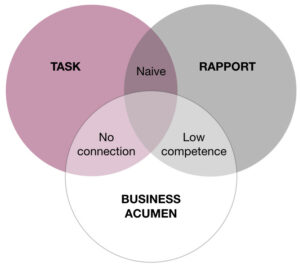Your business might be growing but if it’s just down to a couple of people to generate the income, its success will always be precarious, its value uncertain and its future at risk.
Imagine a company where revenue generation is split between all senior and mid-level employees. That structure has financial stability as well as financial success. The risk is spread, and so is the opportunity. When all senior staff are firing financially, the benefits are not just topline but have knock-on effects which deliver bottom line advantage – and not just as a flow-through from sales.
Increasing the number of people bringing business into your company makes the whole business stronger by delivering higher revenue, greater market penetration, greater stability, higher staff satisfaction and retention – all contributing to higher net profit. (Ask me for my white paper on how this works).

No doubt you have a great team. They deliver great work, on time, on budget, on strategy, on brief. Clients say they’re pleased. So how come other companies are muscling in on your client?

Maybe you have a niggling concern. Are your senior team leaders building relationships? Are they spotting opportunities? Are they taking all the work that’s on the table? And if they’re not, are they making enough of a contribution to the bottom line?
Perhaps they are amazing at their work, but that’s only going to take them so far. To move from being Passive Brief Recipients to Collaborative Brief Generators is a significant step. The magic happens working together with clients to identify needs and scope work.
Three Levers
To achieve this, doing good work is not enough, we need to be pulling two additional levers: Building Rapport, and Business Acumen

Lever 1: Task
Hopefully you know this part.
Simply put, you need to be good at your job in today’s world. Your team needs to be good at their jobs – they need to be able to work accurately and intelligent, answer questions and develop solutions. The company needs to be abreast of the developments in technology and thinking that affect your work, or your clients’ businesses. Then you can evolve or develop your IP, processes, techniques, and technology to optimise your offer.
Lever 2: Building Rapport
Social Psychologist Amy Cuddy states that in order to engage and impress we first need to be trusted. Trust comes before impressing. Building rapport requires engaging as a person. The fastest way to do this is to watch, listen and observe how your client prefers to work and communicate. Are they a detail person or a do they only want to talk about the big picture? Are they steady and process-driven or do they want to rush ahead? All those bubbly people-skills will drive clients away if they prefer to keep their distance. Building rapport comes from what you talk about and how you communicate – verbally and non-verbally. From the ‘in the lift’ chat to email conversations and presentations, rapport can be destroyed by not recognising how your client sees the world and how they prefer to communicate.
If you’re asked how the work is going, do you know whether to make your answer about the process, the detail, the engagement of the stakeholders or how quickly your client will be able to move forward? Choosing the wrong one for your client can make you seem tedious and pedantic when you wanted to sound thorough or careless and headstrong when you thought you were being visionary.
There are learnable skills for identifying your client’s preferred mode of communication and trainable techniques for being able to smooth the waters by responding to them in the way they find easiest to deal with.
Most importantly, when the client feels comfortable with your team, your company becomes more enjoyable to work with and easier to share information with – and more business opportunities arise. Your team becomes not only ‘people who do a great job’ but ‘people who understand me and are easy and enjoyable to work with’.
Lever 3: Business Acumen
The third lever involves understanding their business – not just as it directly affects your work, but as it frames and creates the need for your work and the environment your work feeds into.
Pulling levers 1 and 2 can get you a long way, but if you want to be the go-to company, your team needs to be able to pull this third lever. Larger budgets and higher profile work, the sort of work that gives your team a sense of achievement, exists further up the food chain. The key to moving your company up to the more rewarding work, where you can make more of a difference, is pulling all three levers.
Does your team know what the challenges are for the client company from a commercial perspective, as well as in your specialist field? Are they able to spot opportunities where your service could help the company commercially? Are they able to have proactive conversations, building and scoping work that could help meet the client company’s goals? Can they identify the company’s pain points? Can they proactively offer suggestions – ones that really address a business objective?
Again, these skills are teachable, the techniques are trainable and taking these into the meeting, your team can identify opportunities and ensure no work is left on the table for competitors.
Power of Three
Use of all three levers, being great at your work, developing rapport and having business acumen are what will take your company to the next level. Senior consultants need to be using the full set of tools to bring in the work your company deserves to have.






